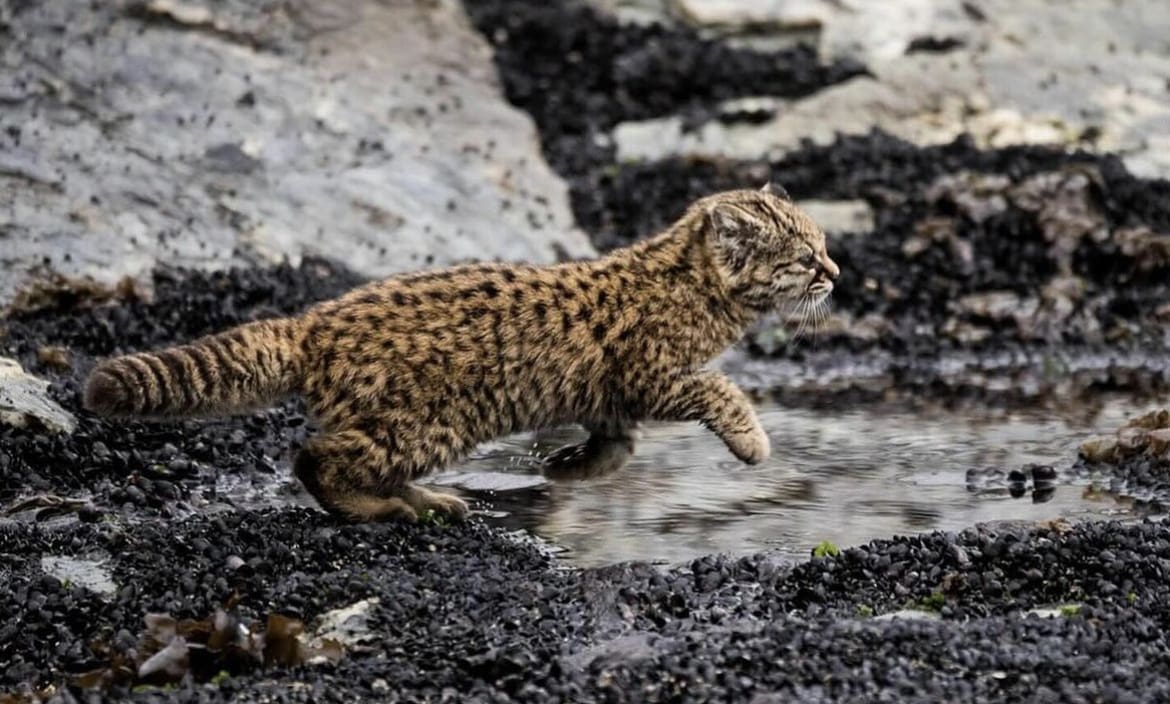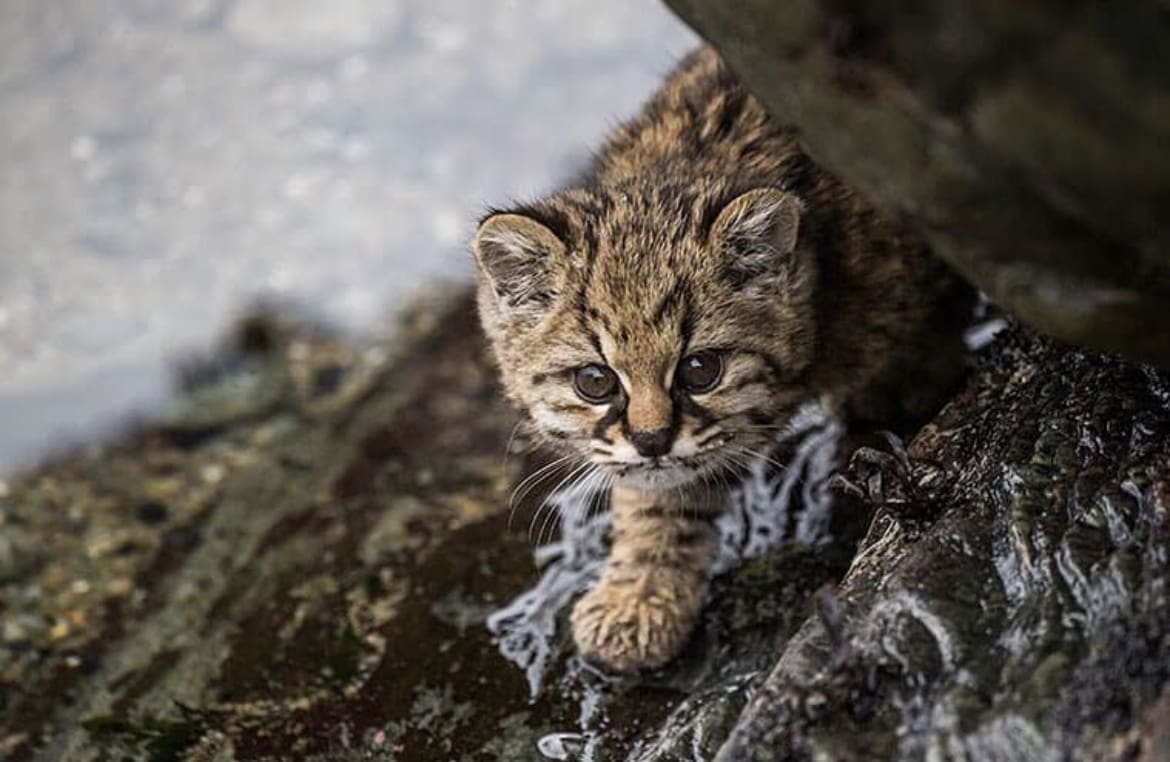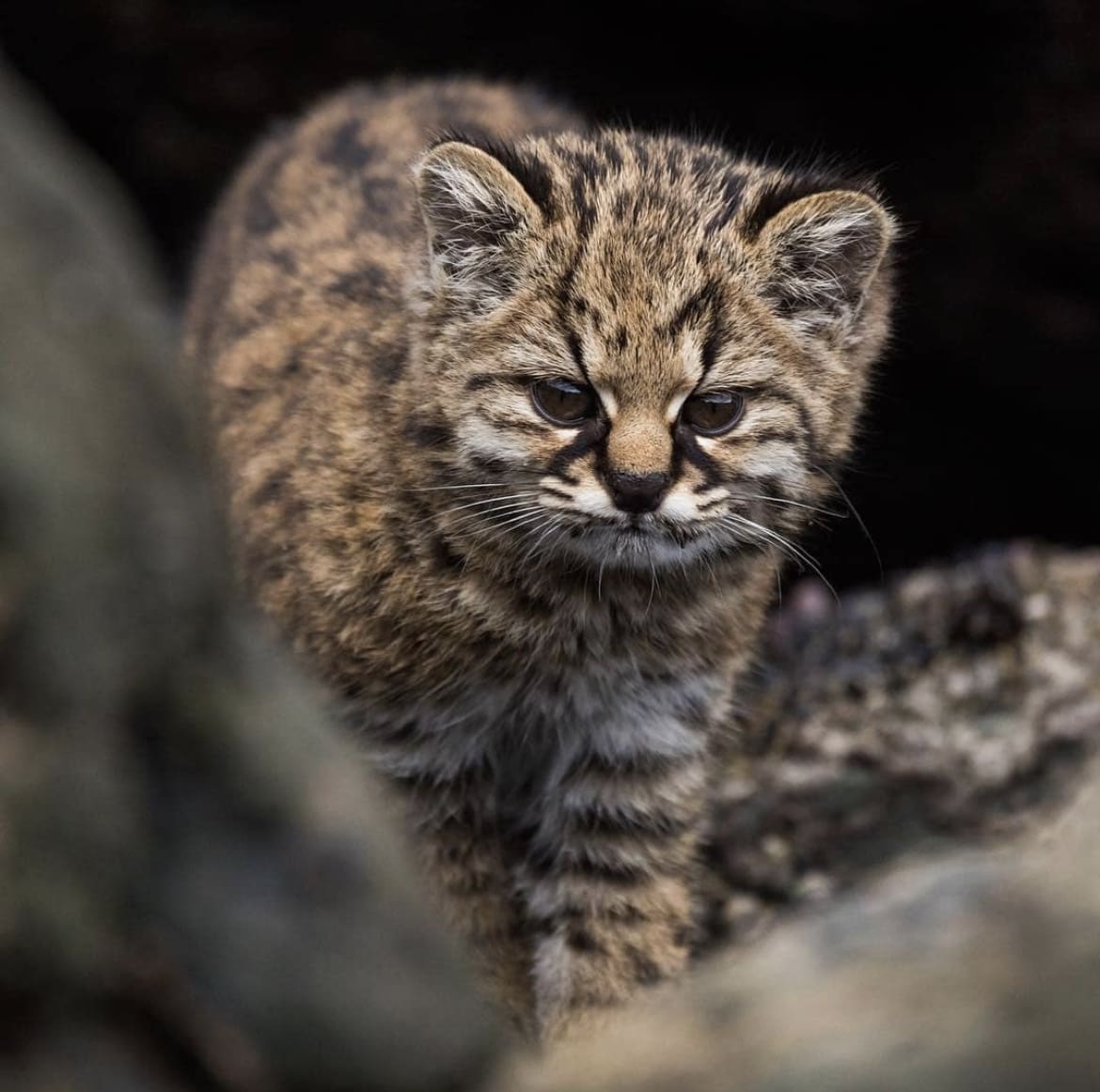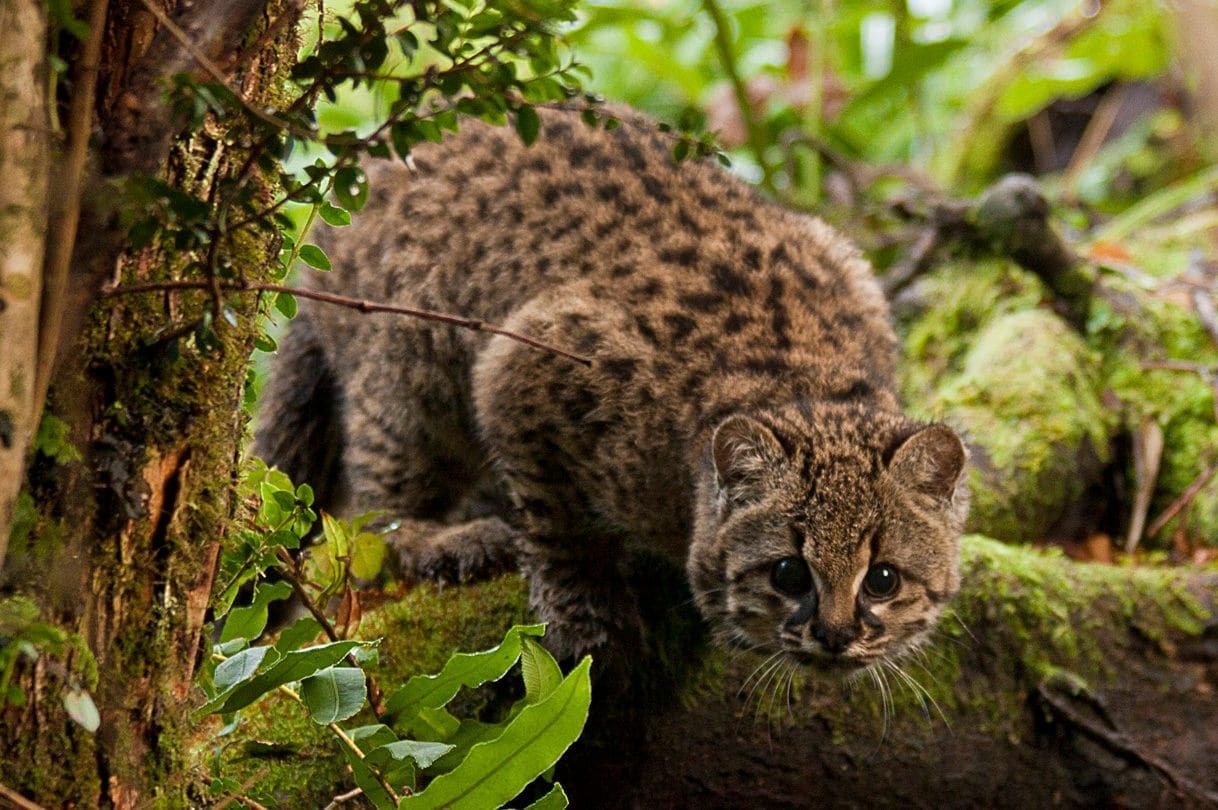[social_warfare]
Meet the KodKod, one of the most intriguing yet underrated stars of the wild cat family. Often overshadowed by its bigger, flashier cousins, this pint-sized predator packs a whole lot of mystery and charisma into a small package.
So, grab your explorer’s hat, and let’s get up close and personal with nature’s own stealthy little ninja, shall we?
What is the KodKod?
The KodKod, also known as the guigna (Leopardus guigna, if you want to get scientific), is South America’s answer to the question, “How adorable can a wild cat get?” Found predominantly in the dense, mystical forests of the Andean region, this little furball prefers its homes Chilean with a side of Argentine.
It’s like the secretive, nocturnal neighbor who knows the neighborhood better than anyone but keeps to themselves. Despite its elusive nature, the KodKod plays a crucial role in the local ecosystem, keeping small rodent populations in check and thus maintaining a healthy balance.

What does the KodKod look like?
Imagine, if you will, a domestic cat that’s decided life’s too short to not wear a fur coat that screams “wild.” KodKods sport a luxurious, thick coat that’s a mosaic of greys, browns, and blacks, interspersed with distinctive spots and stripes that would make any fashionista jealous.
Their faces are a masterpiece of nature’s design, with striking markings that accentuate their expressive eyes. These cats are the epitome of “small but mighty,” with a presence that belies their size.
How big are KodKods?
Now, when we say small, we’re not talking “slightly smaller than your average housecat” small. We’re talking “could probably sneak into your house and you wouldn’t notice” small. Adult KodKods are about the size of a large domestic kitten, with body lengths ranging from 37 to 51 cm (that’s 14.5 to 20 inches for those who shun the metric system), and they tip the scales at a surprisingly lightweight 2 to 2.5 kg (4.4 to 5.5 lbs).
This compact size is a huge advantage in the dense forests and underbrush of their habitats, allowing them to navigate with a ninja-like grace that larger cats can only dream of.
KodKod Skin
The KodKod’s skin is like its personal suit of armor, albeit a very soft and cuddly one. This isn’t just any ordinary cat fur; it’s a thick, plush coat designed to keep the KodKod warm and camouflaged in its cool, often misty mountainous environment.
The skin beneath is tough and flexible, allowing these agile cats to twist, turn, and leap through the dense underbrush and tree branches of their habitat without a scratch. It’s nature’s perfect balance of durability and comfort, tailored to the needs of a creature that lives life on the edge… of branches.

KodKod Teeth
When it comes to dining in the wild, the KodKod’s teeth are its most prized utensils. Sharp and efficient, their dental toolkit is perfectly adapted for a carnivorous diet. With a set of canines that would make Dracula envious, KodKods are equipped to tackle prey much larger than their diminutive stature might suggest.
These teeth are not just for show; they’re designed to deliver the killing bite to small mammals and birds, the main staples of the KodKod diet. So, while they might look cute and cuddly, remember, these little guys are fierce predators at heart.
KodKod Eyes
Ah, the windows to the soul—and in the case of the KodKod, the windows to a world seen mostly under the cover of night. KodKod eyes are large and luminous, optimized for seeing in low light conditions. This nocturnal hunter relies on its exceptional night vision to track down unsuspecting prey under the cloak of darkness.
Their eyes are a striking feature, often a deep, mesmerizing amber or green, that seems to glow with an inner light. It’s this keen eyesight that makes the KodKod such an effective hunter, able to spot and stalk its prey with remarkable precision in the dead of night.
What do KodKods eat?
KodKods are the ultimate opportunistic diners, with a palate as diverse as the South American forests they call home. Primarily, these pint-sized predators feast on a menu of rodents, birds, and insects, showcasing their adaptability and resourcefulness. Every now and then, they might indulge in a reptilian appetizer or perhaps a small marsupial, just to keep things interesting.
Their diet reflects their role as vital controllers of small animal populations, ensuring a balanced ecosystem. In essence, KodKods are not picky eaters; if it scurries or flutters and fits in their mouth, it’s dinner.

How do KodKods hunt?
The KodKod’s hunting technique is a blend of patience, stealth, and precision—a true testament to their wild instincts. These cats are solitary hunters, preferring the cover of night or the dim light of dawn and dusk to stalk their prey. Utilizing their compact size and camouflaged fur, they can get incredibly close to their target without detection.
Once in range, a burst of speed and a leap that would make any Olympian proud seal the deal. KodKods are also adept climbers, not above snagging a bird or two right out of the tree branches. Their hunting strategy is a game of silence and shadow, proving that in the wild, size isn’t everything.
KodKod social structure
Now, if you’re picturing the KodKod as the social butterfly of the feline world, think again. KodKods value their privacy more than your average celebrity, leading mostly solitary lives.
Each KodKod stakes out a territory that they patrol and defend with all the ferocity their little bodies can muster. Encounters between KodKods are rare and usually reserved for the mating season, or when a mother is raising her young. This preference for solitude is reflected in their territorial markings and the serious attitude they take to trespassers. Imagine the grumpiest landlord, and you’ve got a pretty good idea of a KodKod defending its turf.
How does the KodKod reproduce?
KodKods lead secretive lives, and this extends to their reproduction habits. When it’s time to mingle, they momentarily ditch their solitary lifestyle for a brief romantic encounter. Mating usually occurs during the southern hemisphere’s summer months. The female prepares a secluded den, often in dense vegetation or among rocky crevices, as a safe haven for her upcoming litter.
After a gestation period of about 72-78 days, the female gives birth to a small brood, typically one to three kittens. These mini KodKods are born blind and utterly dependent on their mother. She fiercely protects and nurtures them until they’re ready to strike out on their own at around 8-10 months old. This period is crucial for the kittens to learn essential survival skills, including hunting techniques and territory marking.

How long do KodKods live?
In the wild, the lifespan of KodKods remains somewhat of a mystery, largely due to their elusive nature. However, it’s estimated that they live for about 10 years, a respectable age for such a small carnivore.
This can vary depending on factors like habitat quality, availability of prey, and pressure from predators (including humans). In captivity, with the absence of these stressors and regular veterinary care, KodKods can live slightly longer, offering a glimpse into their potential longevity under ideal conditions.
Are KodKods aggressive?
The term ‘aggressive’ might conjure images of ferocious beasts, but for KodKods, it’s all about context. Towards humans and larger predators, KodKods generally adopt a policy of avoidance rather than confrontation. They’re more likely to slip away into the shadows at the first sign of danger. However, when cornered or threatened, they won’t hesitate to defend themselves with all the ferocity their small frames can muster.
Towards each other, outside of mating season, interactions are marked by territorial disputes. KodKods can be fiercely protective of their hunting grounds, leading to aggressive encounters with other KodKods trespassing in their area. This territorial aggression ensures that each KodKod has enough space and resources to survive, a critical aspect of their solitary lifestyle.
Are KodKods territorial?
Absolutely, KodKods are the quintessential territorial animals. They’ve got a “This land is my land, and not your land” kind of attitude, marking their territory with scents to signal “keep out” to any would-be intruders. This behavior is crucial for their survival, ensuring they have exclusive access to the resources within their home range.
Males, in particular, are known to patrol and defend large territories, overlapping with several females’ territories, which are generally smaller. These territorial boundaries are maintained with a mix of physical markers, scent marking, and vocalizations to avoid unwanted confrontations. In the rare event of an overlap, KodKods can get into fierce scuffles, proving that size is no measure of fierceness.

How fast is the KodKod?
While the exact speed of KodKods hasn’t been clocked with a radar gun, it’s clear they’re no slouches. Their small size, agile bodies, and powerful limbs allow for bursts of speed, especially when darting through dense underbrush or chasing down prey. More impressively, their prowess shines in their ability to climb and navigate trees swiftly.
This arboreal agility allows them to leap between branches with the grace of a seasoned gymnast, often using this skill to ambush prey or escape predators. Speed, for a KodKod, is less about breaking records and more about the strategic advantage it offers in their daily survival.
Where do KodKods live?
The KodKod calls the temperate rainforests of South America home, with a range that spans from central to southern Chile and marginally into adjacent areas of Argentina. These cats have a particular fondness for dense forests with thick undergrowth, which provides ample cover for hunting and evasion.
They’re also found in mixed bamboo forests, and on the edge of agricultural areas, showing a degree of adaptability to human-altered landscapes. Elevationally, KodKods are versatile, residing from sea level up to the tree line in the Andes Mountains, demonstrating their broad tolerance for different environmental conditions.
Their habitat preference underscores the need for dense cover and vertical space, highlighting the importance of conserving these ecosystems not just for the KodKods but for the myriad other species that share their home.
How many KodKods are there in the wild?
Quantifying the exact number of KodKods in the wild is a challenging task, primarily due to their elusive nature and dense habitat preferences. However, it’s widely acknowledged that their numbers are not as robust as we’d hope, with fragmented populations scattered across their range.
The IUCN Red List classifies the KodKod as Vulnerable, suggesting that their populations are at risk, though specific numbers are hard to pin down. Research and conservation efforts are ongoing to better understand their population dynamics, but it’s clear that habitat fragmentation and loss are major concerns affecting their numbers.
Are KodKods endangered?
Yes, the KodKod is considered Vulnerable to extinction according to the IUCN Red List. This status is a step away from being endangered but indicates a high risk of endangerment in the wild if current trends continue. The primary threats to their survival include deforestation and habitat loss due to agriculture, logging, and urban expansion.
Additionally, the effects of climate change on their forest habitats could pose future challenges. Their vulnerability highlights the urgent need for conservation measures to protect these small but significant predators and their ecosystems.
Threats to the KodKod in the wild
The survival of the KodKod is threatened by several key factors, most of which are human-induced. Deforestation for timber, agriculture, and urban development has led to significant habitat loss and fragmentation, isolating KodKod populations and limiting their access to food and mates. This habitat degradation also makes it easier for domestic and feral animals to encroach on their territories, leading to competition for resources and transmission of diseases.
Additionally, while not commonly targeted by hunters, KodKods can be caught in traps set for other animals or face persecution from poultry farmers. Climate change poses an emerging threat, with changing precipitation patterns and temperatures potentially altering their forest habitats. These challenges underscore the need for integrated conservation efforts that address both the protection of KodKod habitats and the mitigation of direct human impacts.
Where to see the KodKod in the wild
For the intrepid wildlife enthusiast, catching a glimpse of the KodKod in its natural habitat can be the highlight of a South American adventure. The best chances lie within Chile’s protected national parks and reserves, where the dense forests they favor are preserved.
Parks in the Lake District and parts of the Valdivian rainforest offer potential hotspots, especially for those willing to venture out at dusk or dawn, when KodKods are most active. Guided tours focusing on wildlife can increase your chances, with local guides knowledgeable about the most likely spots and times to observe these elusive cats.
Tips for spotting KodKods
Spotting a KodKod requires patience, respect for their habitat, and a bit of luck. Here are some tips to increase your chances:
- Time your visit: Aim for dawn or dusk when KodKods are most active.
- Move quietly: Stealth and silence are key, as noise can easily scare them away.
- Look up: KodKods are skilled climbers; don’t forget to scan the trees.
- Stay on the lookout for eyeshine: Their reflective eyes can be a giveaway in the low light.
- Keep your distance: If lucky enough to spot one, maintain a respectful distance to avoid causing stress.
- Hire a local guide: Their expertise can be invaluable in locating these cats.
Facts about the KodKod
- The KodKod is the smallest wild cat in the Americas.
- It has the smallest geographical range of any wild cat, living only in Chile and parts of Argentina.
- KodKods have exceptionally large home territories for their size, up to several square kilometers.
- They are excellent climbers, often hunting and resting in trees.
- KodKods can live up to 10 years in the wild, sometimes longer in captivity.
Myths about the KodKod
- Myth: KodKods are just wild versions of domestic cats. Truth: While small, KodKods are wild animals with distinct behaviors and needs.
- Myth: They pose a significant threat to livestock. Truth: KodKods primarily hunt small rodents and birds, rarely targeting farm animals.
- Myth: KodKods can be tamed as pets. Truth: Despite their size, they are wild creatures with specific habitat and dietary needs that cannot be met in a domestic setting.
The KodKod, with its shadowy lifestyle and diminutive stature, encapsulates the mystique and beauty of the wild. These cats remind us of the vast diversity of life that shares our planet and the importance of each species, no matter how small, in the intricate web of ecosystems. By understanding and respecting these creatures, we can take steps towards ensuring their survival and the preservation of their habitats.
Let the KodKod serve as a symbol of the wild’s resilience and vulnerability, inspiring us to advocate for conservation efforts that protect the natural world for generations to come. The story of the KodKod is a call to action—a reminder that in the conservation of nature, every species counts, and every effort matters.


